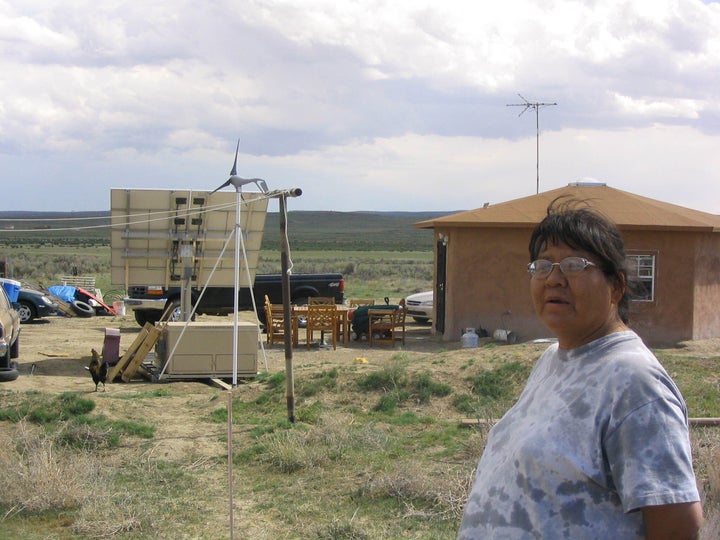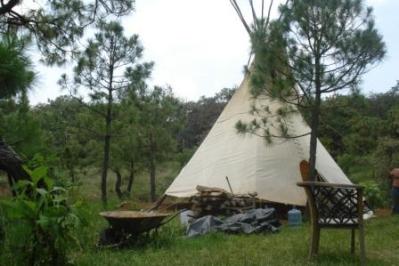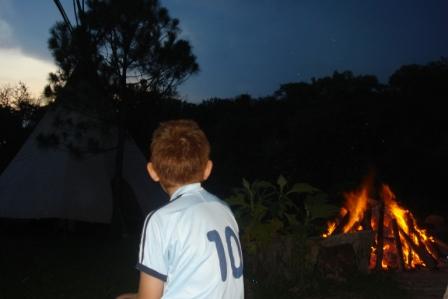
The old man, bare stomach protruding over his shorts, pointed to brightly painted psychedelic paintings for sale in his hut, while three tiny toddlers peeped in the window and begged for "a peso." "This is a fire," the Huichol shaman explained to me, pointing at three flames shooting out and connecting with the tail of a snake. "It is sacred because what can we do without fire?" The great sun at the top of the painting was the Great Spirit who created the universe, and the ever-present rattles with feathers were the shaman's tools.
After this quick introduction to Huichol culture in the lively town of Tepic, I got in the SUV with my fellow Mexican companions and shot over the hills for Guadalajara, for an all-night Navajo tipi ceremony. A famed Navajo chief -- former head of the Native American Church (and principally responsible for the legality of peyote for ceremonies in the US) -- had come down expressly for the occasion: Emerson Jackson.

The road to the ceremony already seemed sacred, mounting into a grassy knoll, surrounded by lakes. Evening had not yet descended, and the participants were excitedly mulling around a fire, in a hush, including the youngest (non) participant, a little baby named Emilia. Nearby the fire were dozens of cars and tents: people had come from as far away as the Yucatan for the occasion -- and most, it seemed, were among the elite middle class of Mexico.
I started to take a picture of the fire, and a man started: "Have you asked permission to take a picture of the sacred fire?"
The fire was heating the rocks for our initiation ceremony: the purification ritual of Temascal. Eventually, when the crickets began chirping in the dusk, the women wrapped themselves in cloths and lined up to enter the rounded hut, symbolically the womb of Mother Earth, bowing their heads at the entrance. "Para todos mi relaciones," each said, speaking not just about their family members, but their relations to the stones, the trees, the plants, the world at large.
As we took our seats cross-legged in a sacred circle -- always moving clockwise -- one woman asked permission if we could go topless, as this was unusually a Temascal ceremony without men. The chief nodded. After all, it made no difference: it was pitch dark behind the canvas folds.
In a gentle grandfatherly voice, the Chief told us a story of a coyote and two dogs -- the point of which was lost to me as the steam swelled to a boiling pitch in the small enclosure. Three times, the men came shoveling in steaming rocks, each announced with holy awe, as "from the Mother Earth."
Then -- purified to the last drop -- we women tiptoed single-file out the hut, and ran to the lake under the stars, and jumped in laughing into the water. My body felt clean and delicious in the cold. Meanwhile, it was the men's turn.
It was a long while before we -- dressed ceremoniously in skirts and dress shirts -- entered the tipi, taking our seats quietly in a circle, and sitting for what was another long while before the chief was ready to begin. First, in his gentle grandfatherly voice, he chastised us for beginning the ceremony so late. Now that it was midnight, for the proper ceremony to begin, it would have to go until noon.

His voice lulled me to a pleasant buzz as I stared into the center fire, around which a half circle was drawn in the dust. The "moon," the chief explained, signified our life journey: beginning as children and ending as old people, about to die. Speaking of which, he noted, he would like us to pray for him, to ask God to give him a long life.
And no matter where we were on that lunar path, young or old, it was good.
I wondered whether the little boy next to me would be taking the peyote as well -- but no, he curled into a circle under a shawl and fell asleep. It was warm in the tipi, and with him next to me, and the two young girls squished on the other side, and behind me, my companions who had invited me, I felt already physically uncomfortable, a slipped disc in my spine.
But all was interesting. Especially now that the chief was passing around loose tobacco for each of us to roll a cigarette for the tobacco ceremony. Afterwards, our cigarette butts would be collected and put along the lunar trace, to represent each of us in our sacred journey.
The singing began. The chief and a fellow leader of the ceremony, a Huichol marakame -- one distinguished by the characteristic high cheekbones and tall stance of the Navajo, the other more rounded and wizened -- began to sing alternatively Huichol and Lakota songs, while shaking a rattle, praising, I was told, the spirits.
Then suddenly the peyote was passed around. This seemed a surprisingly informal part of the ceremony: a big bowl of awful tasting squishy cactus, which each member dipped a hand into, to come up with a fistful of little soft nougats. We had to pass the bowl with our left hand, in a circular gesture, to our neighbor to the left.
As we chewed with our back teeth, the official drummer came around and paused at each person around the circle, offering each the chance to chant, while he beat the drum. The most veteran participants volunteered, the women with clear crystalline voices, the men shaking their arms and fists while they rhythmically belted out a melodic chant. I noted each singer used the opportunity to passionately express her or himself, eyes crinkled almost in tears, deep belly-aching chords shaking in the body.
The participants were engrossed, believing in the bowl, the spirit of Peyote, the words of the chief as he now admonished us to learn how to pray.
The peyote seemed to have no effect on me, except to remind me all the more of how uncomfortable I felt in groups -- especially squished in a circle -- and at an opportune moment, I snuck to the door for fresh air, and a new seat with more space. "May I sit here?" I asked the fire-bearer, a rough handsome dude with an intensely concentrated look and big muscular arms. He nodded.
Yet by changing my seat, it also meant that the peyote, which passed in regular half-circles, skipped me. I tried to ask the fire-bearer to help correct the situation, but he first shook his head stolidly, and then quipped, "You made a mistake to leave your seat!"
Now the Navajo chief was talking about love and gratefulness to the universe, and all sorts of warm sentiments that I was sure if only I had some peyote, I might appreciate as fully as my fellow participants, who were drowsily nodding with pleasure at each word. Instead, for me, the time went by slowly: four o:clock -- was it indeed already four o:clock?
After another hour, I protested again, to ask whether the peyote could come my way, which led to a bit of an uproar with the chief, and me being told to go back to my original seat, clock-wise, of course: at which point the peyote was passed to the half-circle I had left.
"Hey Chief, can I have some more medicine for myself!" the fire-bearer called out. "Somehow it skipped me."
"Of course!" The man lumbered up and grabbed a fistful.
My life-long discomfort with groups reached a peak right then -- and whether influenced by the three kernals of peyote I had taken six hours before or not -- I decided to go take a break in the SUV.
Minutes later, when I went back in to take my seat, the chief stopped the ceremony and came to me to whisk an eagle feather around my face, as if I were sick, or had brought in bad energy. In the morning, indeed, the fire-bearer explained that I had broken so many rules, I had endangered the harmony of the group and had to be purified.
"We do not pray enough," the chief was explaining to us. And in a beautiful gesture, he invited each of us, one by one, to come to the fire and throw cedar chips into it, while asking the God to hear our prayer. One girl burst into tears and prayed for her mother. Another beautiful young woman, with creamy skin and a big full belly, came in melodic Spanish and prayed for the health of her newly coming son, and for the love between her, him and her husband to be harmonious and healthy. She finished her prayer by lifting up her shirt and exposing her rounded belly to the fire.
"AHO!" the participants called out. It was the Navaho way to say amen.
And indeed, the Navaho way to say amen also included "amen." After each of his prayers or chants, Emerson Jackson would raise his arms and say "Amen." Earlier, in a brief chat in the tipi, one on one, he had curiously explained to me that the Navajo conception of God is actually identical to the Christian: the great spirit is like Jesus, there is just one God.
In the wee hours of the morning, as light began to come up -- and I munched on my first handful of peyote (still to no effect) -- the chief warmly regaled us with an oration about mothers. "Who taught you your first step?" he asked, reminding us of what we each surely had forgotten.
The young woman with the dying mother began to sob at the other end.
"And who took care of you when you were sick? Who cradled you when you could not do anything for yourself?"
"The mother," the chief said.
In appreciation of the female spirit, he asked a woman to bring in the morning water, as he had asked a man to bring in the evening water, for balance.
Each gesture was planned: this Navajo ceremony was step-by-step carried out the same way as all Navajo ceremonies, from the tobacco blessing to the now ceremonious "parting of the chief", as he stood up and strode across the tipi outside to come back in.
We seemed a great family by this point, and it was time now for our communal breakfast: a symbolic bowl of corn, a symbolic bowl of meat, a symbolic bowl of grapes. Each was passed around, and each participant took a handful or two and munched. The Huichol chief's little emaciated daughter grabbed the most handfuls of the corn, as well as the grapes.
"Time for thanks."
The chief went around and thanked each of us individually, giving a personal touch to each member. I feared being thanked as the one who disrupted the ceremony, but no he thanked me as the lady who came from France.
Then it was our turn -- in copious tearful orations -- to thank and bless the Navajo chief. "I am so honored you are come to us,": said one woman. "I am so full of gratitude. I...I love you."
The thanks went on for an hour, two hours, as if nobody wanted to leave the warm hearth of the tipi, even when the fire had been ceremoniously extinguished. Here was community, here was family, here was the Chief.
Eventually, however, the group traipsed individually out of the tipi, for hugs and fruit and tacos outside in the bright morning.
For me, it was a dip back in the lake and a sudden feeling of happiness---love and gratefulness even. Indeed, the fire-bearer greeted me with a big hug and a moving apology: "I am really sorry," he said. (To be frank, I had--in a tete-a-tete the night before--called him a jerk).
Perhaps the peyote had been a "teacher" to me, as they say? While I rather lamented the fact that I saw no hallucinations, shapes, lights or special effects (what is expected with peyote, which is chemically "mescaline"), the idea is that the sacred plant peyote meets you ":where you are", and perhaps, for me, that was precisely in profound unease with group dynamics?
In any event, I was glad I had done the ceremony.
Especially since eventually everyone left except for a core group of die-hards, including the adorable little baby, and the fire-bearer who was explaining to his sixteen year old nephew, with fatherly words, that if he had begun doing ceremonies as young as the boy, he would never have "wasted his youth" with drugs and dissolute ways. The young boy stared at his tattooed uncle appreciatively and nodded.
We 10 eventually were to go back for a "closing" purification into the Temascal.
As they heated the rocks, I spoke to the chief, sitting weakly in a fold-out chair, his cane next to him. He remembered I lived in Europe -- although became confused at one point and thought it was Spain -- and spoke pointedly about how he had been in Germany himself, stationed there, before he had done four years of service in Vietnam.
He shook his head. He did not want to talk about Vietnam.
How about life on the reservation?
He had loved it, to the point that being in the cities seemed noisy to him, and he always went back to the land. It was the land that spoke to him.
He sat in his chair quietly, staring straight ahead into the trees, and spoke slowly, and eventually stopped speaking altogether and waved his hand at me. "Enough," he said.
Yet I noted that later wherever I walked, he stared at me, as I stared at him: one of the last remaining Navajo chiefs, I thought.
We entered -- men and women -- in robes into the rounded hut. "A todos mis relaciones!" This time I too was moved to tears.
As the fire-man shoveled in each stone -- "de la Madre Tierra!" -- we each called out AHO. Then the drummers -- four of us had drums -- began to drum and chant Lakota songs, loud and resonate in the darkened hut, as sweat rolled down our bodies. Three times the rocks were brought in, and drenched with water, while our new leader -- the jolly bearded owner of the hacienda -- waved a eucalyptus branch with drops at our faces.
Then came the prayers. For poor children all over the world. AHO! For sick mothers. AHO! For protection of the environment! AHO! The Mother Womb is supposed to be the most powerful hearth for prayers, and as we chanted into the heat, the emotion reached a rhythmic pitch.
An hour later, when we had sweated to the bone, the leather door was lifted open, the cool morning streamed in, and each of us bowed to the earth, leaning our drenched bodies into the earth. "A todos mis relaciones!"
Into the lake, we dove.
* * *
Csikszentmihalyi's theory of flow is that this is what makes people happy, to be thoroughly absorbed in what they are doing -- which is becoming more rare these days, he points out, because people get brainwashed about what it is they want to do, what it is they should do -- becoming cogs in our cultural wheels -- and forget what it is they love. Csikszentmihalyi supplements one of his books, "Finding Flow", with many charts of subjects who calculated the hours of the days when they felt active attention -- and happiness -- and when they felt passive.
Although he himself does not make an issue of it, what is striking is that 30 percent of the useless passive time, when people did not seem to be "living", was spent watching television.
The flow times occurred when people were engrossed in either work, study or leisure (sports and movies).
It occurred to me as the days passed -- and I spent time with the erstwhile tipi participants at breakfast, lunch and dinner -- that all they spoke about, rapturously, was the ceremony -- as well as previous ceremonies and anticipated future ceremonies. "My life was empty before," said more than one of the aficionados. "Even though I had family, love and wealth." "My husband and I met at a ceremony," said another glowing woman with soft dark eyes, showing me pictures of their wedding, dressed in gorgeous indigenous clothes, in a tipi.
What are these modern upper-class Mexicans seeking, I thought (along with spiritual connection, of course), in embracing these indigenous traditions (which are not theirs) but "flow": some activity that engrosses them, makes life meaningful, and asks them to be "attentive" -- as apparently nothing else had fit the bill? The fire, the peyote, the tobacco in our hands, the mother tierra rocks were tools to focus attention, to embrace emotion, to create a group swayed into enchantment, much like in the ceremony of movie-watching (my own field), the images of the screen do the same for spectators who, having gone single-file through the ticket line, take seats together in a theater, to suspend, for a moment, our cynicism and disbelief and become engrossed in another world.

